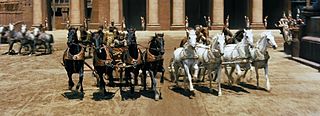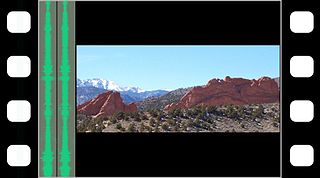- The DP70 pedestal and mechanism seen from the operating side, with the mechanism cover closed.
- The DP70 pedestal and mechanism seen from the operating side, with the mechanism cover open.
- A detailed view of the mechanism, with the gate retracted. The projector is seen here in 35mm configuration.
- 35mm film threaded in the mechanism (white spacing), through the picture gate and analog optical audio head.
- Digital optical penthouse readers fitted to the top of the mechanism chassis. Clockwise from left: 35mm Dolby Digital (threaded), 70mm DTS and 35mm SDDS.
- The non-operating side of the projector, showing the retrofitted motor for variable speed operation (bottom left). A viewing porthole (center right) enables the projectionist to confirm visually that oil is circulating while the mechanism is running.
- The custom-built power supply control panel for the motors of the two Philips DP70 projectors in the Egyptian Theatre, Hollywood. Any frame rate between 16 and 30 can be selected, and the two motors can also be interlocked to enable the projection of left and right eye 3D prints.
- The manufacturer's data plate for one of the two DP70s in the Egyptian Theatre, Hollywood. It is attached to the pedestal, and therefore the "made in USA" statement is technically correct. The mechanism, however, was manufactured at the Philips factory in Eindhoven, The Netherlands.
Related Research Articles

35 mm film is a film gauge used in filmmaking, and the film standard. In motion pictures that record on film, 35 mm is the most commonly used gauge. The name of the gauge is not a direct measurement, and refers to the nominal width of the 35 mm format photographic film, which consists of strips 1.377 ± 0.001 inches (34.976 ± 0.025 mm) wide. The standard image exposure length on 35 mm for movies is four perforations per frame along both edges, which results in 16 frames per foot of film.

70 mm film is a wide high-resolution film gauge for motion picture photography, with a negative area nearly 3.5 times as large as the standard 35 mm motion picture film format. As used in cameras, the film is 65 mm (2.6 in) wide. For projection, the original 65 mm film is printed on 70 mm (2.8 in) film. The additional 5 mm contains the four magnetic stripes, holding six tracks of stereophonic sound. Although later 70 mm prints use digital sound encoding, the vast majority of existing and surviving 70 mm prints pre-date this technology.

IMAX is a proprietary system of high-resolution cameras, film formats, film projectors, and theaters known for having very large screens with a tall aspect ratio and steep stadium seating, with the 1.43:1 ratio format being available only in few selected locations.

CinemaScope is an anamorphic lens series used, from 1953 to 1967, and less often later, for shooting widescreen films that, crucially, could be screened in theatres using existing equipment, albeit with a lens adapter.

Cinerama is a widescreen process that originally projected images simultaneously from three synchronized 35mm projectors onto a huge, deeply curved screen, subtending 146-degrees of arc. The trademarked process was marketed by the Cinerama corporation. It was the first of several novel processes introduced during the 1950s when the movie industry was reacting to competition from television. Cinerama was presented to the public as a theatrical event, with reserved seating and printed programs, and audience members often dressed in their best attire for the evening.

A movie projector is an opto-mechanical device for displaying motion picture film by projecting it onto a screen. Most of the optical and mechanical elements, except for the illumination and sound devices, are present in movie cameras. Modern movie projectors are specially built video projectors.

Todd-AO is an American post-production company founded in 1953 by Mike Todd and Robert Naify, providing sound-related services to the motion picture and television industries. For more than five decades, it was the worldwide leader in theater sound. The company retains one facility, in the Los Angeles area.
Sensurround is the brand name for a process developed by Cerwin-Vega in conjunction with Universal Studios to enhance the audio experience during film screenings, specifically for the 1974 film Earthquake. The process was intended for subsequent use and was adopted for four more films, Midway (1976), Rollercoaster (1977), the theatrical version of Saga of a Star World (1978), the Battlestar Galactica pilot, as well as the compilation film Mission Galactica: The Cylon Attack (1979). Sensurround worked by adding extended-range bass for sound effects. The low-frequency sounds were more felt than heard, providing a vivid complement to onscreen depictions of earth tremors, bomber formations, and amusement park rides. The overall trend toward "multiplex" cinema structures presented challenges that made Sensurround impractical as a permanent feature of cinema.

Panavision is an American motion picture equipment company founded in 1954 specializing in cameras and lenses, based in Woodland Hills, California. Formed by Robert Gottschalk as a small partnership to create anamorphic projection lenses during the widescreen boom in the 1950s, Panavision expanded its product lines to meet the demands of modern filmmakers. The company introduced its first products in 1954. Originally a provider of CinemaScope accessories, the company's line of anamorphic widescreen lenses soon became the industry leader. In 1972, Panavision helped revolutionize filmmaking with the lightweight Panaflex 35 mm movie camera. The company has introduced other cameras such as the Millennium XL (1999) and the digital video Genesis (2004).

A projectionist is a person who operates a movie projector, particularly as an employee of a movie theater. Projectionists are also known as "operators".
Dolby Stereo is a sound format made by Dolby Laboratories. It is a unified brand for two completely different basic systems: the Dolby SVA 1976 system used with optical sound tracks on 35mm film, and Dolby Stereo 70mm noise reduction on 6-channel magnetic soundtracks on 70mm prints.
70 mm Grandeur film, also called Fox Grandeur or Grandeur 70, is a 70 mm widescreen film format developed by William Fox through his Fox Film and Fox-Case corporations and used commercially on a small but successful scale in 1929–30.

Technirama is a screen process that has been used by some film production houses as an alternative to CinemaScope. It was first used in 1957 but fell into disuse in the mid-1960s. The process was invented by Technicolor and is an anamorphic process with a screen ratio the same as revised CinemaScope (2.35:1), but it is actually 2.25:1 on the negative.

Mitchell Camera Corporation was an American motion picture camera manufacturing company established in Los Angeles in 1919. It was a primary supplier of newsreel and movie cameras for decades, until its closure in 1979.

Film perforations, also known as perfs and sprocket holes, are the holes placed in the film stock during manufacturing and used for transporting and steadying the film. Films may have different types of perforations depending on film gauge, film format, and intended usage. Perforations are also used as a standard measuring reference within certain camera systems to refer to the size of the frame.
Cine 160 is a 35 mm film projection process proposed by Allan Silliphant whereby a single frame of film would occupy a length of six film perforations. This could then be used for either of two currently proposed applications: 3-D film projection from two images each occupying 3 perforations, or making anamorphically squeezed prints of 1.85 ratio films, which would use a greater amount of image area. The system is named Cine 160 because the six-perf frame uses 1.60 times the area of a conventional print. This system has not yet received any mainstream application, however, and it is unknown how receptive theater owners will be to the prospect, which will require significant expenses to re-fit projectors to the format.

Ultra Panavision 70 and MGM Camera 65 were, from 1957 to 1966, the marketing brands that identified motion pictures photographed with Panavision's anamorphic movie camera lenses on 65 mm film. Ultra Panavision 70 and MGM Camera 65 were shot at 24 frames per second (fps) using anamorphic camera lenses. Ultra Panavision 70 and MGM Camera 65's anamorphic lenses compressed the image 1.25 times, yielding an extremely wide aspect ratio of 2.76:1.
The Whiteladies Picture House is a cinema on Whiteladies Road in Clifton, Bristol, England.

Anamorphic format is the cinematography technique of shooting a widescreen picture on standard 35 mm film or other visual recording media with a non-widescreen native aspect ratio. It also refers to the projection format in which a distorted image is "stretched" by an anamorphic projection lens to recreate the original aspect ratio on the viewing screen. The word anamorphic and its derivatives stem from the Greek anamorphoo, compound of morphé with the prefix aná. In the late 1990s and 2000s, anamorphic lost popularity in comparison to "flat" formats such as Super 35 with the advent of digital intermediates; however, in the years since digital cinema cameras and projectors have become commonplace, anamorphic has experienced a considerable resurgence of popularity, due in large part to the higher base ISO sensitivity of digital sensors, which facilitates shooting at smaller apertures.
References
- ↑ "DP70: The Story of the Todd-AO Projector".
- ↑ "Kinoton History". Kinoton.de. Germering, Germany: Unknown. Archived from the original on 5 March 2014. Retrieved 6 May 2014.
- ↑ "Kinoton is Latest Victim of Switch to Digital Cinema". Celluloid Junkie. Unknown: Unknown. 1 April 2014. Archived from the original on 16 April 2014. Retrieved 6 May 2014.
- ↑ Gartenbaukino. "Technische Austattung". Gartenbaukino. Retrieved 2022-06-27.
- ↑ "Lens and Lights | Projection". lnl.wpi.edu. Retrieved 2023-09-20.
- ↑ "Norelco Universal 70-35 Projector" (PDF). in70mm.com. Buffalo, New York: Norelco. 1955. Archived from the original (PDF) on 16 October 2012. Retrieved 6 May 2014.
- ↑ "DP70: The Story of the Todd-AO Projector".
- ↑ invoice from 1956–12
- ↑ Invoice from 1959–09
- ↑ Bauer Kino Technisches Taschenbuch







